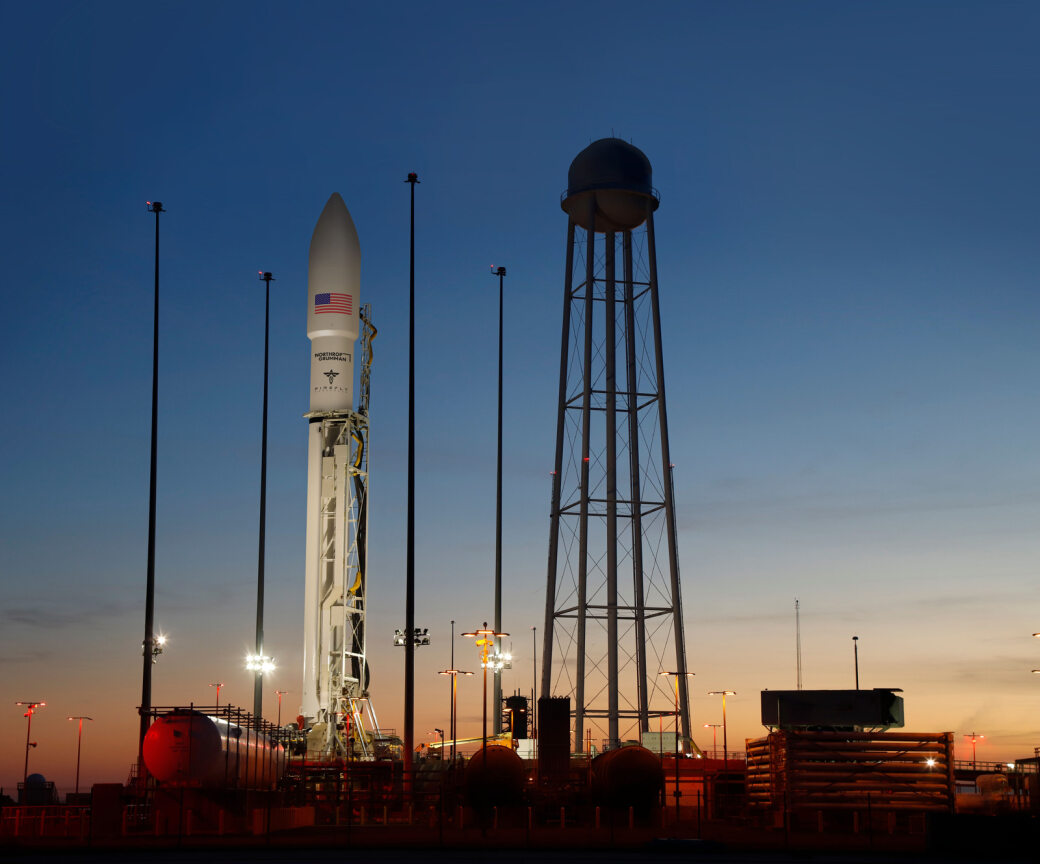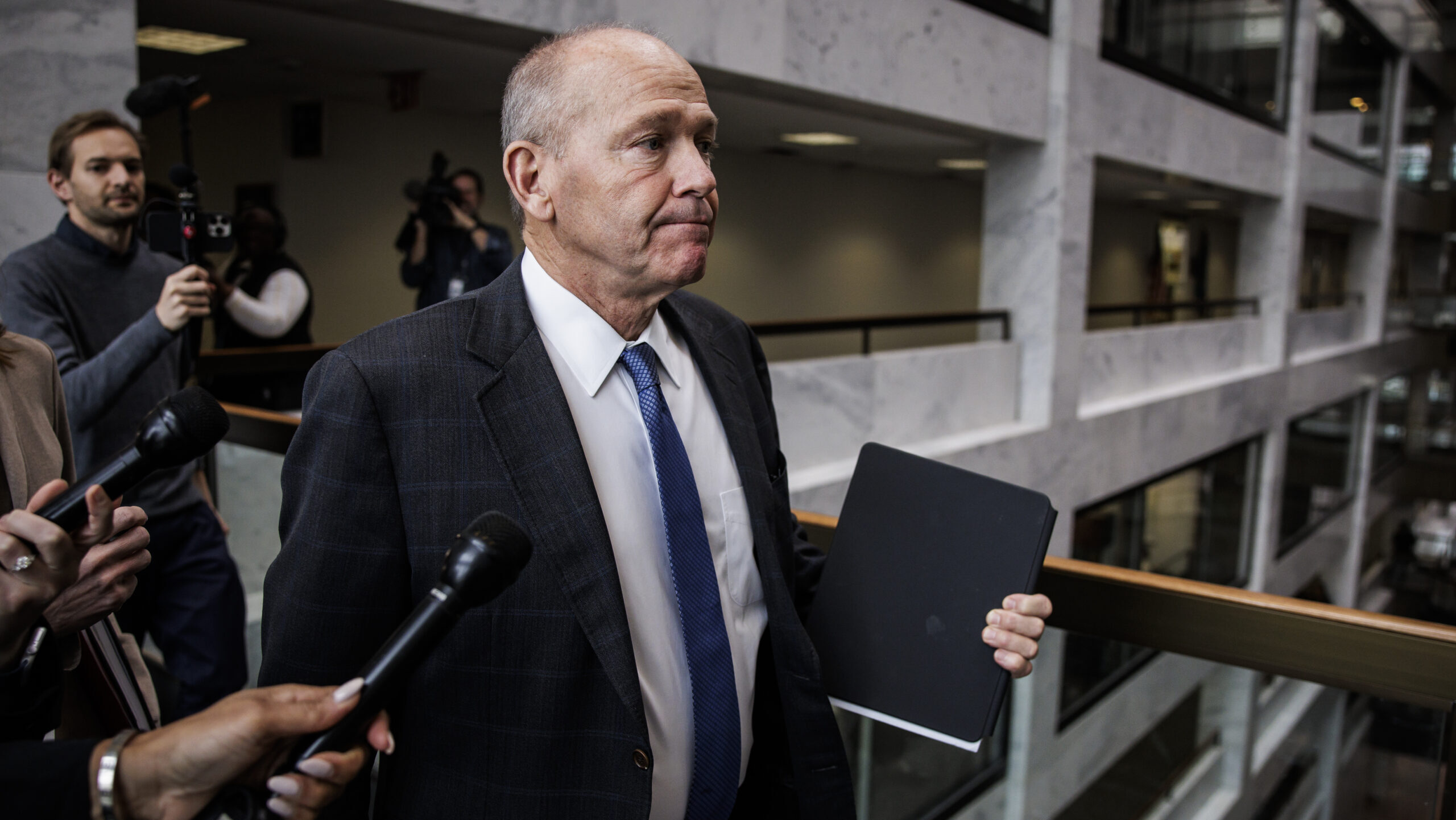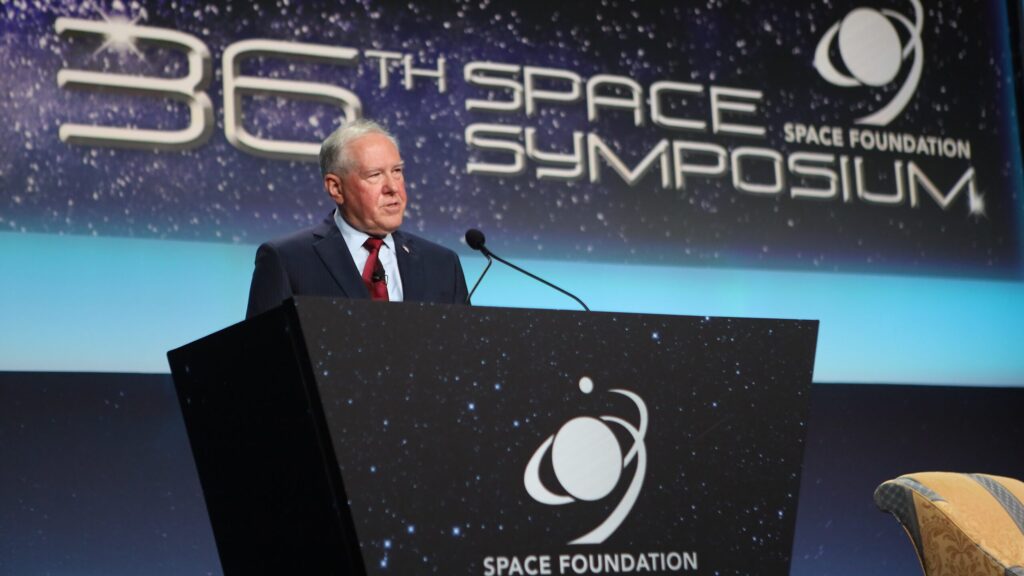
Air Force Secretary Frank Kendall speaks at the 2021 Space Symposium. (Courtesy Space Symposium)
WASHINGTON — The Space Force seeks $29.4 billion in the Pentagon’s fiscal 2025 budget request, a 2 percent drop from its $30 billion ask in fiscal 2024, but should still be able to maintain momentum in building up capabilities to counter China, according to Air Force Secretary Frank Kendall.
“So, the net effect of the constraints that we have are that we’re not moving forward as fast as I’d like to in space, but what we’re still moving forward,” he told reporters in a budget pre-brief with other top Department of the Air Force officials on Friday.
He explained that the “small decrease in the number for the Space Force” isn’t itself quite reflective of reality, as there are mitigating circumstances that lessen the blow.
“There are two things that help explain that,” Kendall said. “One is that launches have slipped because payloads have not been ready. So … we will have a smaller number of launches than we had planned last year.”
For more coverage of the FY25 budget release, click here.
Service briefing charts show that Space Force’s FY25 procurement budget request of $4.3 billion (down from $4.7 in FY24) includes $1.8 billion for seven launches under the National Security Space Launch program, vice the 10 launches funded at $2.1 billion in FY24. The FY25 request also slates $375 million for four launches for the Space Development Agency (SDA), down from almost $500 million for five launches planned in the FY24 request.
The second is that there is “some work” in the Department of the Air Force’s “pass through” funding of $45.1 billion that goes to the Intelligence Community, in large part the National Reconnaissance Office, that actually “directly contribute to the capabilities of the Space Force,” Kendall said.
While the details of the passthrough are classified, it stands to reason that it includes funds for the development of new satellites to track moving targets on the ground. The Space Force asked for $243 million in its FY24 budget request — and slightly more than $1.2 billion over the five-year Future Years Defense Program (FYDP) — for Ground Moving Target Indicator and “auxiliary” payloads under a program called Long-Range Kill Chains. However, the service later came to an agreement with NRO that would see the service paying the spy-sat agency to acquire the new satellites, under Defense Department oversight.
“So, the picture you get when you look at the pure number [for the Space Force top line] is not entirely accurate, because of those two factors,” Kendall said.
“Overall, I consider this to be an acceptable budget. I can defend it. It is moving forward on the things that we prioritized. Again, I’d like to be able to move faster, but we do have constraints,” he added.
The Problem For Space Is China
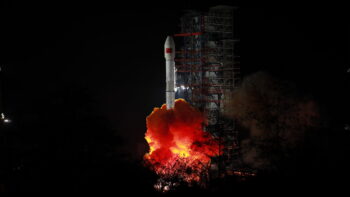
A Chinese Long March-3B carrier rocket lofts the Tiantong 1-03 satellite, a new mobile telecommunications satellite. (Photo by Guo Wenbin/China News Service via Getty Images)
The Space Force’s budget since its inception has been weighted toward research, development, test and evaluation (RDT&E), as the service gears up myriad new efforts to re-focus its force structure on “great power competition” with Russia and, especially, China.
“We’ve really got a problem with space. China has fielded a combination of anti-satellite capabilities and space-based targeting capabilities. So they’re threatening our space assets and they’re threatening our joint force, and we’ve got to respond to that,” Kendall explained.
“We’re making good progress, I think, on the resiliency side of the equation, making our space assets more resilient. I’d like to move faster on that than we currently are. But we’re making good progress there,” he added. “We’re making some progress on counterspace, but that’s another area … in which I’d like to make progress more quickly than I am right now.”
Kendall stressed that of his seven operational imperatives for the Air and Space Force, the top three are focused on space. Number one is creating an effective “space order of battle,” he said. “And the second one, on Joint All Domain Command Control, is very dependent upon space. The third one on targeting is all about space, right, increasingly about space. So, when I look at achieving the operational imperatives, space is critical to that.”
RDT&E: A Small Hit, But Key Programs Get Bumped Up
The service asked for a total of $18.7 billion in FY25 RDT&E, down slightly from its FY24 request of $19.2 billion, according to its briefing charts. DoD has yet to release the so-called j-books that provided detailed, line-item budget numbers; instead providing macro-numbers and highlighting a few programs in its briefings.
Of those RDT&E programs highlighted, the Next-Generation Overhead Persistent Infrared (Next-Gen OPIR) missile warning/tracking constellation — including satellites in geosynchronous Earth orbit (GEO) and polar orbit, as well as the Future Operationally Resilient Ground Evolution ground system — took the biggest hit, falling from a request of $2.6 billion in FY24 to $2.1 billion in FY25. However, Maj. Gen. Michael Greiner, Air Force deputy assistant secretary for budget, explained that some of that change was due to savings achieved from last year’s decision to cut an originally planned third satellite in GEO.
A number of programs aimed at improving resiliency — by proliferating the number of satellites an enemy would need to take out to effectively cripple operations — did receive small boosts.
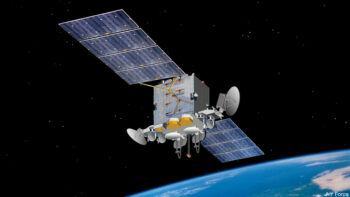
Advanced Extremely High Frequency (AEHF) provides nuclear-survivable, encrypted national security communications. (Photo: Space Force archive)
The Space Force asked for $1 billion in FY25 for the Evolved Strategic SATCOM program to replace the aging Advanced Extremely High Frequency (AEHF) satellites for encrypted, nuclear-survivable national security communications, up from $600 million in FY24, as the program nears production.
Likewise, the Protected Tactical SATCOM program to build a more robust network for troops on the ground, in the air and at sea would see $600 million under the service’s FY25 request, up from $400 million in FY24.
In addition, funding would increase over the FY24 request by $111 million in the FY25 request for a few efforts to improve space domain awareness — including the the Deep Space Advanced Radar Capability (DARC) and the SILENTBARKER satellites being development in tandem with NRO for on-orbit surveillance of adversary spacecraft, Greiner said. He did not, however, provide further details or breakdown the individual program budgets.
Lastly, the Space Force briefing charts show yet another planned increase in RDT&E funding for missile warning/tracking satellites, with $2.6 billion slated in FY25 versus $2.3 billion in the FY24 request. The FY24 request itself was $1.1 billion more than appropriated in FY23. The funds cover both SDA’s planned Tracking Layer constellation in low Earth orbit, and Space Systems Command’s embryonic development of another set of satellites in medium Earth orbit — both being optimized for keeping tabs on hypersonic missiles.
More People, More Training Capability
Finally, the service’s Operations and Maintenance (O&M) costs are going up, including a small boost of 400 personnel from planned FY24 levels to 9,800, to allow for “targeted investments in operational force elements and training elements. The Space Force asked for $5.2 billion in O&M for FY25, up from $4.9 billion requested in FY24.
For sustainment, the Air Force briefing charts note that the FY25 request of $1.4 billion (the same as in the FY24 request) will cover 81 percent of the requirements for 52 planned weapon systems. The Space Force request also includes $114 million to “enhance Operational Test & Training Infrastructure.”
